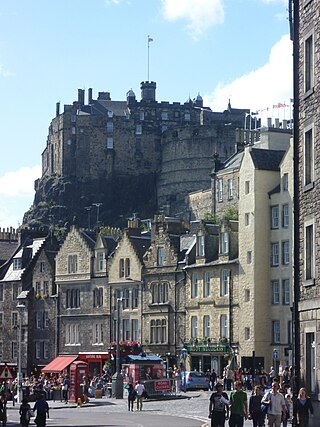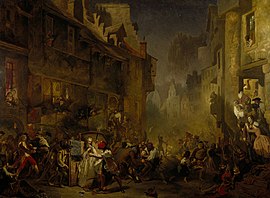
1736 (MDCCXXXVI) was a leap year starting on Sunday of the Gregorian calendar and a leap year starting on Thursday of the Julian calendar, the 1736th year of the Common Era (CE) and Anno Domini (AD) designations, the 736th year of the 2nd millennium, the 36th year of the 18th century, and the 7th year of the 1730s decade. As of the start of 1736, the Gregorian calendar was 11 days ahead of the Julian calendar, which remained in localized use until 1923.

The National is the national art gallery of Scotland. It is located on The Mound in central Edinburgh, close to Princes Street. The building was designed in a neoclassical style by William Henry Playfair, and first opened to the public in 1859.

Alexander Runciman was a Scottish painter of historical and mythological subjects. He was the elder brother of John Runciman, also a painter.

The Porteous Riots surrounded the activities of Captain John Porteous, Captain of the City Guard of Edinburgh, Scotland, who was lynched by a mob for his part in the killing of innocent civilians while ordering the men under his command to quell a disturbance during a public hanging in the Grassmarket, Edinburgh in April 1736. Although the rioters were generally supportive of the convicted smugglers, Porteous seems to have been a somewhat overbearing official, despised by the mob and the underclasses of Edinburgh society.
Captain John Porteous was a Scottish military officer who served in the Edinburgh City Guard and played a major role in the Porteous Riots, which resulted in his death.

The Royal Scottish Academy (RSA) is the country’s national academy of art. It promotes contemporary Scottish art.

The Grassmarket is a historic market place, street and event space in the Old Town of Edinburgh, Scotland. In relation to the rest of the city it lies in a hollow, well below surrounding ground levels.

The Heart of Mid-Lothian is the seventh of Sir Walter Scott's Waverley Novels. It was originally published in four volumes on 25 July 1818, under the title of Tales of My Landlord, 2nd series, and the author was given as "Jedediah Cleishbotham, Schoolmaster and Parish-clerk of Gandercleugh". The main action, which takes place between September 1736 and May 1737, is set in motion by the Porteous Riots in Edinburgh and involves an epic journey from Edinburgh to London by a working-class girl to obtain a royal commutation of the death penalty incurred by her sister for the alleged murder of her new-born baby. Despite some negative contemporary reviews, some now consider it Scott's best novel.

The West Port is a street in Edinburgh's Old Town, just south of Edinburgh Castle. It runs from Main Point to the southwest corner of the Grassmarket.
Events from the year 1736 in Great Britain.

James Drummond FSA was an artist and the curator of the National Gallery of Scotland from 1868 to 1877. He was also an early photographer.

There have been several town walls around Edinburgh, Scotland, since the 12th century. Some form of wall probably existed from the foundation of the royal burgh in around 1125, though the first building is recorded in the mid-15th century, when the King's Wall was constructed. In the 16th century the more extensive Flodden Wall was erected, following the Scots' defeat at the Battle of Flodden in 1513. This was extended by the Telfer Wall in the early 17th century. The walls had a number of gates, known as ports, the most important being the Netherbow Port, which stood halfway down what is now the Royal Mile. This gave access from the Canongate which was, at that time, a separate burgh.

The Old Tolbooth was an important municipal building in the city of Edinburgh, Scotland, for more than 400 years. The medieval structure, which was located at the northwest corner of St Giles' Cathedral and was attached to the west end of the Luckenbooths on the High Street in the Old Town, was first established in the 14th century by royal charter. Over the years it served a variety of purposes such as housing the Burgh Council, early meetings of the Parliament of Scotland and the Court of Session. The Tolbooth was also the burgh's main jail where, in addition to incarceration, physical punishment and torture were routinely conducted. From 1785 public executions were carried out. In 1817 the buildings, which had been rebuilt and renovated several times, were demolished.
Events from the year 1818 in Scotland.
Events from the year 1736 in Scotland.
Events from the year 1737 in Scotland.

The malt tax riots were a wave of protest against the extension of the English malt tax to Scotland. The riots began in Hamilton on 23 June 1725 and soon spread throughout the country. The fiercest protests, the Shawfield riots, were in Glasgow, but significant disturbances occurred in Edinburgh, Stirling, Dundee, Ayr, Elgin and Paisley.
Patrick Lindsay (1686–1753) was a British Army officer and Scottish politician who sat in the House of Commons from 1734 to 1741. In 1736, the Porteous Riots broke out in Edinburgh, and Lindsay was sent to seek help from the Army which turned out badly.

West View of the City of Edinburgh is an engraving by the landscapist, Paul Sandby. This engraving on paper was published in 1753 and has an alternate name, Vue Occidentale de la Ville d'Edinbourg Capitale d'Ecosse. This portrayal of the city of Edinburgh was transferred from Scottish National Portrait Gallery to the Scottish National Gallery of Modern Art.












